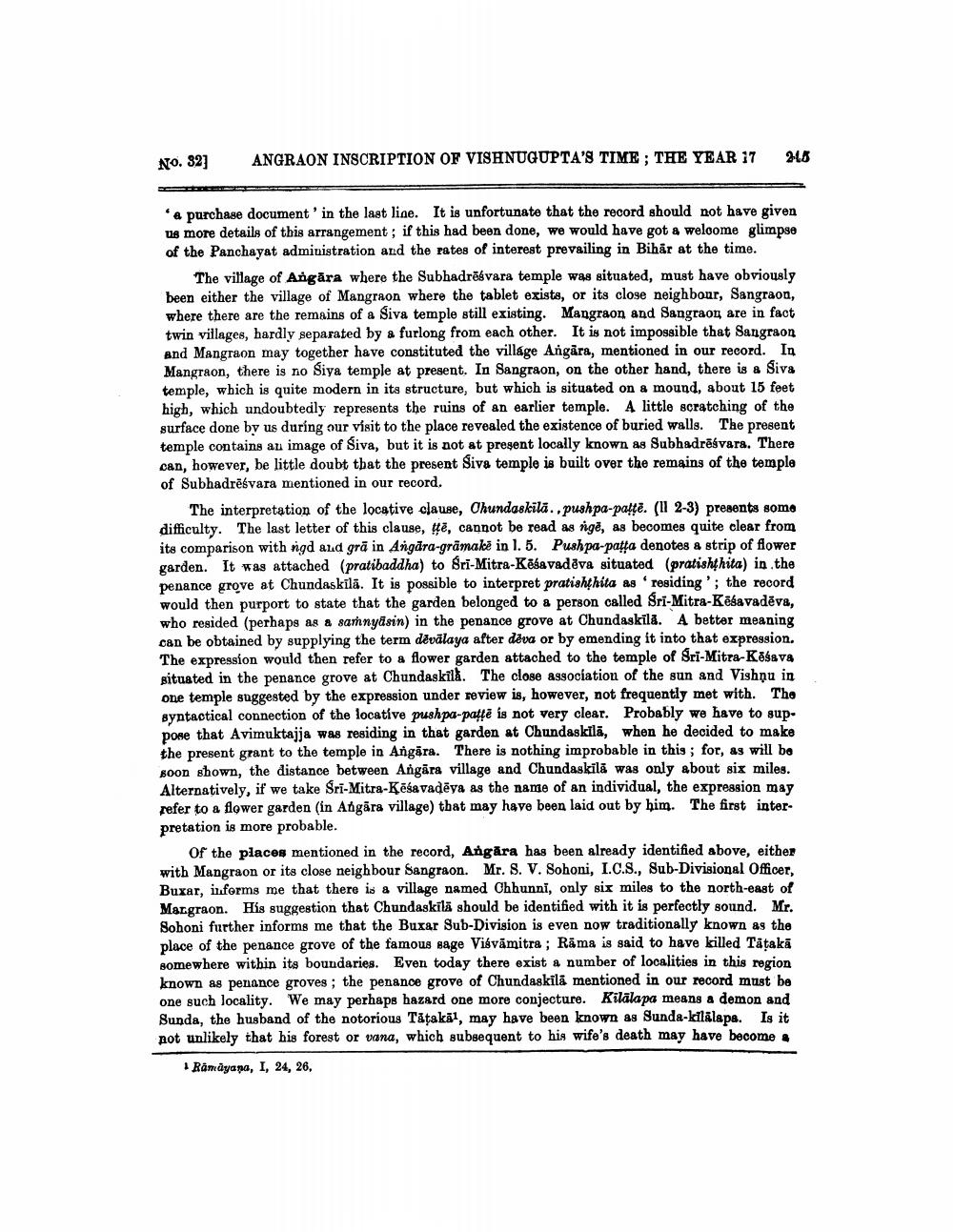________________
NO. 32)
ANGRAON INSCRIPTION OF VISHNUGUPTA'S TIME ; THE YEAR 17
248
'a purchase document' in the last line. It is unfortunate that the record should not have given us more details of this arrangement; if this had been done, we would have got a weloome glimpse of the Panchayat administration and the rates of interest prevailing in Bihar at the time.
The village of Angāra where the Subhadrēsvara temple was situated, must have obviously been either the village of Mangraon where the tablet exists, or its close neighbour, Sangraon, where there are the remains of a Siva temple still existing. Mangraon and Sangraon are in fact twin villages, hardly separated by a furlong from each other. It is not impossible that Sangraon and Mangraon may together have constituted the village Angāra, mentioned in our record. In Mangraon, there is no Siya temple at present. In Sangraon, on the other hand, there is a Siva temple, which is quite modern in its structure, but which is situated on a mound, about 15 feet high, which undoubtedly represents the ruins of an earlier temple. A little scratching of the surface done by us during our visit to the place revealed the existence of buried walls. The present temple contains au image of Siva, but it is not at present locally known as Subhadrësvara. There can, however, be little doubt that the present Siva temple is built over the remains of the temple of Subhadrēsvara mentioned in our record.
The interpretation of the locative clause, Chundaskila..pushpa-palca. (ll 2-3) presents somo difficulty. The last letter of this clause, te, cannot be read as ngë, as becomes quite clear from its comparison with nigd and gra in Angāra-grāmakė in 1. 5. Pushpa-patta denotes & strip of flower garden. It was attached (pratibaddha) to Sri-Mitra-Kēšavadēva situated (pratishthita) in the penance grove at Chundaskila. It is possible to interpret pratishthita as residing '; the record would then purport to state that the garden belonged to a person called Sri-Mitra-Kësavadēva, who resided (perhaps as a samnyasin) in the penance grove at Chundaskila. A better meaning can be obtained by supplying the term devälaya after deva or by emending it into that expression. The expression would then refer to a flower garden attached to the temple of Sri-Mitra-
K ava situated in the penance grove at Chundaskilà. The close association of the sun and Vishnu in one temple suggested by the expression under review is, however, not frequently met with. The syntactical connection of the locative pushpa-paffe is not very clear. Probably we have to suppone that Avimuktajja was residing in that garden at Chundaskila, when he decided to make the present grant to the temple in Angāra. There is nothing improbable in this; for, as will be soon shown, the distance between Angāra village and Chundaskila was only about six miles. Alternatively, if we take Sri-Mitra-Ķēšavadėya as the name of an individual, the expression may refer to a flower garden (in Angāra village) that may have been laid out by him. The first interpretation is more probable.
Of the places mentioned in the record, Angara has been already identified above, either with Mangraon or its close neighbour Sangraon. Mr. S. V. Sohoni, I.C.S., Sub-Divisional Officer, Buxar, informs me that there is a village named Chhunni, only six miles to the north-east of Margraon. His suggestion that Chundaskilä should be identified with it is perfectly sound. Mr. Sohoni further informs me that the Buxar Sub-Division is even now traditionally known as the place of the penance grove of the famous sage Vibvāmitra ; Rāma is said to have killed Tätakā somewhere within its boundaries. Even today there exist a number of localities in this region known as penance groves ; the penance grove of Chundaskilä mentioned in our record must be one such locality. We may perhaps hazard one more conjecture. Kilalapa means a demon and Sunda, the husband of the notorious Tatakāl, may have been known as Sunda-kilalapa. Is it not unlikely that his forest or vana, which subsequent to his wife's death may have become
Ramayana, I, 24, 26,




